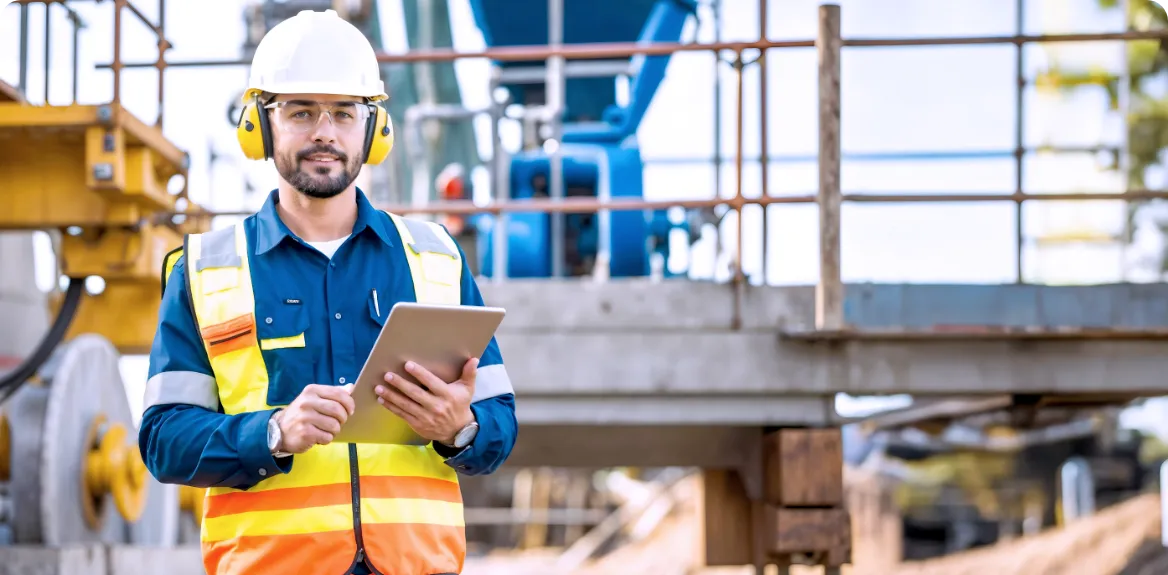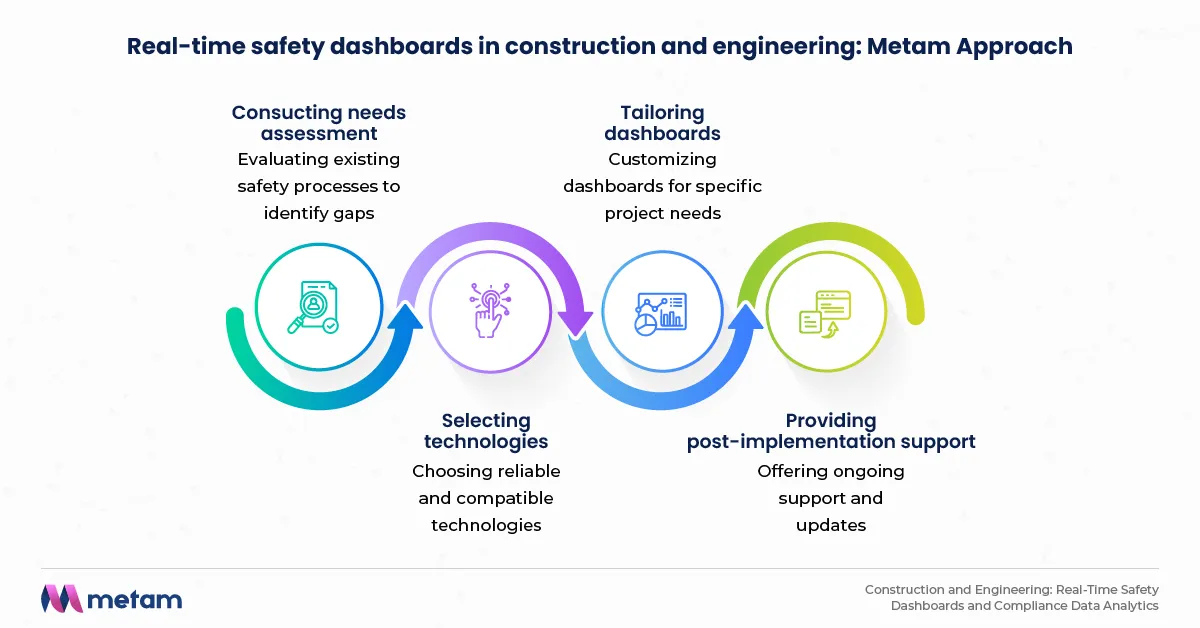Construction and engineering: Real-time safety dashboards and compliance data analytics
by
Metam technologies

Abstract
Real-time safety dashboards and compliance data analytics are revolutionizing safety management in construction and engineering. These technologies provide immediate, actionable insights to improve on-site safety and ensure regulatory compliance. They help streamline risk management and enhance operational efficiency.
Table of Content
What are real-time safety dashboards and how do they enhance construction and engineering site safety?

How does compliance data analytics improve regulatory adherence in construction and engineering projects?

What are the challenges in adopting real-time safety dashboards in construction and engineering?

How Metam leverages real-time safety dashboards for construction and engineering firms ?

Key takeaways

In the construction and engineering industries, safety management is a critical concern that requires constant attention and adaptation. Traditional safety protocols often fall short in addressing the dynamic and complex nature of modern construction sites. The integration of real-time safety dashboards and compliance data analytics is reshaping the approach to safety, offering real-time insights that enable proactive risk mitigation.
The Big Data Analytics in Construction Market was valued at USD 8.4 billion in 2023 and is anticipated to grow at a compound annual growth rate (CAGR) of over 11% between 2024 and 2032, driven by the increasing demand for operational efficiency and cost reduction.
This article examines how these advanced technologies are transforming safety management, ensuring regulatory compliance, and improving overall site efficiency.
What are real-time safety dashboards and how do they enhance construction and engineering site safety?
Real-time safety dashboards are transforming the way safety is managed on construction and engineering sites. These digital platforms provide immediate insights into safety metrics, helping to identify potential hazards before they escalate into accidents.
Defining real-time safety dashboards
Real-time safety dashboards are digital platforms that aggregate and display live data from construction and engineering sites, providing instant insights into safety metrics and compliance status. This allows project managers and safety officers to quickly assess risks and take immediate action. By leveraging sensors, IoT devices, and wearable technology, dashboards can capture real-time data such as worker location, hazardous zones, and equipment status, offering a comprehensive view of the site’s safety landscape.
Key features of effective safety dashboards
Real-time safety dashboards come equipped with a variety of features designed to ensure quick and efficient safety management on-site. These include live data integration, user-friendly interfaces, customizable alerts, and real-time monitoring, all of which play a crucial role in preventing incidents and improving safety protocols. In addition, these dashboards can provide predictive analytics that forecast potential safety issues, allowing for early intervention before accidents occur.
Here are key features of effective safety dashboards in construction and engineering :
- Live data integration: Continuous data flow from IoT devices and sensors.
- User-friendly interface: Intuitive design for easy interpretation of complex data.
- Customizable alerts: Notifications for potential safety breaches or compliance issues.
- Real-time monitoring: Immediate updates on site conditions, allowing quick action to prevent accidents.
- Multi-device compatibility: Accessibility across desktops, tablets, and mobile devices, ensuring safety data is available anywhere, anytime.
- Data-driven insights: Analytical tools that generate actionable insights from collected data, helping to improve safety strategies and processes.
The importance of data visualization
Data visualization is a powerful tool in construction and engineering safety management. By presenting complex safety data in a visual format, dashboards enable workers, managers, and stakeholders to make quick, informed decisions that can prevent accidents and ensure compliance. Visual tools like heat maps, real-time charts, and color-coded alerts help convey critical safety information at a glance, improving response time and awareness at the site.
Improving communication through dashboards
Effective communication is essential for maintaining safety standards on construction and engineering sites. Real-time dashboards improve communication by ensuring that site managers, safety officers, and project leaders have access to up-to-date safety information, enabling them to respond quickly to potential risks. Dashboards often integrate with messaging platforms, sending immediate alerts and status updates to relevant personnel, which helps ensure that safety concerns are addressed in real time.
How does compliance data analytics improve regulatory adherence in construction and engineering projects?
Compliance data analytics allows construction and engineering firms to manage regulatory requirements proactively. By leveraging data-driven insights, firms can ensure adherence to evolving regulations and streamline their compliance processes.
The role of data analytics in compliance
Data analytics enables the analysis of large datasets to identify patterns and predict potential compliance violations before they occur. By analyzing trends and historical data, construction firms can stay ahead of potential regulatory issues and avoid penalties. With the ability to integrate data from various sources, including project management tools, HR systems, and compliance documents, analytics platforms can identify discrepancies and automate reporting, making the entire compliance process more efficient.
Benefits of implementing compliance analytics
Implementing compliance analytics brings a host of benefits, including proactive risk management, enhanced reporting accuracy, and improved decision-making. With predictive insights, firms can allocate resources more efficiently and ensure ongoing regulatory alignment, reducing the likelihood of compliance violations. Furthermore, automated systems can flag inconsistencies in real-time, allowing companies to address issues before they escalate into serious compliance failures.
Here are the key benefits of implementing compliance analytics in construction and engineering:
- Proactive risk management: Addressing issues before they escalate.
- Enhanced reporting accuracy: Reducing human error in compliance documentation.
- Resource optimization: Allocating manpower and materials more efficiently based on predictive insights.
- Improved decision-making: Leveraging data-driven insights to make informed, timely decisions that enhance safety and compliance.
- Regulatory alignment: Ensuring compliance with constantly evolving regulations through automated tracking and updates.
Streamlining compliance reporting
One of the major challenges in the construction industry is ensuring timely and accurate compliance reporting. Compliance data analytics simplifies this process by automating data collection and reporting, reducing human error, and ensuring that regulatory documents are submitted on time. The automation of regulatory report generation allows project teams to focus on core operations while ensuring that compliance deadlines are consistently met, reducing the risk of fines or audits.
Leveraging predictive analytics for compliance risk mitigation
Predictive analytics is a game-changer for construction firms when it comes to compliance risk mitigation. By identifying potential risks before they manifest, firms can take proactive steps to address compliance challenges, minimizing the chances of non-compliance and costly penalties. Predictive models can assess factors like project size, geographical location, and industry-specific regulations to flag areas of heightened risk, ensuring that compliance strategies are continually refined and optimized.
What are the challenges in adopting real-time safety dashboards in construction and engineering?
While real-time safety dashboards offer significant benefits, their adoption can present various challenges. Understanding and addressing these obstacles is crucial for successful implementation.
- Integration with existing systems: Integrating real-time safety dashboards with existing project management and safety protocols can be challenging. Compatibility issues can arise, especially with older systems, requiring careful planning and technical expertise to ensure seamless integration. A robust integration strategy is key to ensuring that the dashboard works well with other tools such as scheduling software, HR systems, and equipment tracking solutions, facilitating a unified approach to safety management.
- Data security concerns: As with any technology that deals with sensitive data, security concerns are a significant issue in real-time safety dashboards. Ensuring that the data collected from construction sites is protected from cyber threats is a key consideration for firms implementing these systems. Advanced encryption methods, multi-factor authentication, and secure cloud storage can be employed to safeguard data integrity and ensure compliance with data protection regulations, reducing the risk of data breaches.
- Training and change management: Successfully adopting real-time safety dashboards requires comprehensive training and change management strategies. Staff must be educated on how to use the new technology and adapt to updated workflows to ensure that the system is utilized effectively. Training should be continuous and hands-on, focusing not only on dashboard functionality but also on instilling a culture of safety and compliance across the workforce, ensuring that the system’s full potential is realized.
- Overcoming resistance to change: Resistance to new technology is common in industries like construction, where traditional methods have been in use for years. Overcoming this resistance requires a thoughtful approach, including clear communication of the benefits of real-time dashboards and offering support during the transition. By showcasing early successes and providing real-time data on safety improvements, companies can encourage buy-in from both frontline workers and management, ensuring smoother adoption.
- Cost and budget considerations: The initial investment in real-time safety dashboards can be a significant barrier for some firms. However, balancing the costs with the long-term benefits of improved safety and compliance management is essential for justifying the investment and ensuring ROI. Many vendors offer scalable solutions, allowing firms to start small and expand the dashboard’s functionality as needs evolve, helping to manage the upfront costs while maximizing long-term value.
How Metam leverages real-time safety dashboards for construction and engineering firms ?
Metam Technologies has been at the forefront of implementing real-time safety dashboards for construction and engineering firms. By focusing on tailored solutions and comprehensive support, Metam ensures that these dashboards integrate seamlessly into existing workflows and provide lasting value.

- Conducting a needs assessment : The first step in implementing real-time safety dashboards is evaluating the current safety processes in place. Metam conducts thorough needs assessments to identify gaps and areas where dashboards can provide the most value, ensuring that the solution is customized to meet each firm's specific requirements.
- This tailored approach ensures that the dashboards deliver relevant insights, enabling firms to address their unique safety challenges and improve overall site performance.
- Selecting the right technologies : Selecting the right technology is crucial for ensuring the success of real-time safety dashboards. Metam leverages its industry experience to choose the most reliable and compatible technologies, offering robust support services to guarantee the system meets the firm's needs. Metam ensures that the chosen solutions align with operational goals.
- Tailoring dashboards for specific project needs : Every construction and engineering project has unique safety challenges. Metam customizes dashboards to meet the specific needs of different projects, ensuring that the system provides the most relevant and actionable data for each site. This customization can include integrating project-specific safety protocols, tailoring alert systems, and adjusting the user interface to ensure ease of use for diverse teams.
- Post-implementation support : Once the dashboards are in place, Metam provides ongoing support to ensure that the system continues to deliver value over time. This includes regular updates, troubleshooting, and training to keep the technology running smoothly and ensure that safety protocols are consistently adhered to. Continuous support also allows for system refinement, ensuring that the dashboards adapt as the firm’s needs evolve over time.
Key takeaways
Real-time safety dashboards provide immediate insights, enhancing on-site safety and compliance in construction and engineering. Compliance data analytics enables proactive risk management and efficient resource allocation.
Successful implementation requires careful planning, addressing integration challenges, and ongoing staff training. Emerging technologies like AI and wearables are set to further revolutionize safety management in construction and engineering.

Construction compliance...
This article explores the transformative role of compliance automation in construction health and safety management,...




